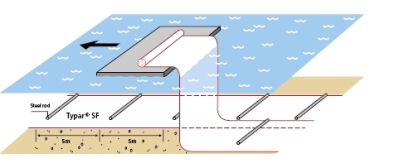Installation guidelines
Article
Temporary Roads
Permanent Roads
Drainage
Erosion control
Temporary roads
Ground separation and support are the two main functions of DuPont™ Typar® in temporary road construction. Since the soil / Geotextile / aggregate system tends to be deformed by imposed traffic loads, special attention must be paid to laps and anchorage:

- Remove all large debris which might puncture DuPont™ Typar®.
- Unroll DuPont™ Typar®. The width of DuPont™ Typar® should be at least as great as that of the aggregate layer.
- If two or more widths are required, ensure sufficient overlap.
- If it is windy, use shovelfuls of coarse aggregate at regular intervals to hold DuPont™ Typar® in place.
- Backdump aggregate without driving on DuPont™ Typar®.
- Level and compact aggregate before any heavy traffic occurs.
- Avoid aggregate size in excess of 1/3 of aggregate layer thickness.
- Fill up ruts, if any, as soon as they exceed 1/3 of aggregate thickness. Rutting will then be stopped.
- First aggregate layer must be at least 25cm thick
Permanent roads
The prime role of DuPont™ Typar® in permanent road construction is that of ground separation. However, during the construction phase the base courses are often used as a temporary road surface and in these cases Typar® also acts as a support membrane. The installation of DuPont™ Typar® in permanent road construction is identical to that for temporary roads.
Drainage systems
- Trenches

- The base and side walls of the trench should be as free of irregularities as possible (holes, roots, etc.). Lay Typar® parallel to the trench and anchor the edges of the fabric.
- Do not drag the fabric in the mud. This will result in the deposit of a large amount of fine particles on the surface of Typar® thus creating an impervious film.
- Off-load the drainage aggregates carefully to avoid the fabric being dragged towards the bottom of the trench.
- Do not use over-large stones to fill up the trench. Gravel of max. size 2 cm is required to ensure good fabric-to-soil contact.
- Compact the aggregate and enclose it with Typar® before backfilling to the top of the trench
- Overlap lengths of Typar® by at least 30 cm.
- Blanket drains

- Overlap min. 30 cm
- Do not unroll Typar® too far in advance, especially in windy conditions
- Use relatively small sized aggregate to ensure good fabric-to-soil contact.
Embankments on compressible soil
A geotextile will stretch considerably during consolidation and settlement and, by providing lateral support, will tend to increase embankment stability horizontal.

- Level surface
- Unroll Typar® perpendicular to the embankment axis to ensure full efficiency in the principal direction of force. Side-laps must be at least 1m.
- If necessary, lengths of Typar® can be sewn together in order to obtain a continuous sheet parallel to the embankment axis.
- To increase rate of settlement it may be beneficial to install a layer of sand or gravel to act as a drainage blanket. In this case Typar® will act as a filter membrane.
Required overlap
The side and end laps needed depend on soil properties (CBR), the project nature and on the deformations which might be expected to occur.
Overlaps normally used
- Drainage systems: 30 cm
- Parking lots, permanent roads: 30 to 50 cm
- Erosion control systems: 50 to 100 cm
- Temporary roads: see graph
Additional area required allowing for overlaps
The two following graphs show the amount of extra DuPont™ Typar® needed, depending on the calculated surface area and the overlap width.
Estimates of the savings possible by sewing or welding instead of overlapping are clearly demonstrated.
For applications where DuPont™ Typar® is used for reinforcement purposes,overlapping requires special attention. Calculations by experienced design engineers may be needed to check the correct transmission of stresses.


- If slope is over 8m, place DuPont™ Typar® in full-width lengths from slope top to bottom. Overlap in direction of waterflow.
- Excavate ditches for anchoring DuPont™ Typar® at top and toe of slope. The toe is the foundation of the structure and should get special attention to prevent undermining.
- When placing rip-rap or gabions, start at toe and work up the slope to prevent sliding. Install rip-rap smoothly, without dropping it heavily onto DuPont™ Typar®.
- To ensure good fabric-to-soil contact, first of all place a layer of bedding material (gravel) on DuPont™ Typar®. This layer will also help prevent puncturing by heavy rip-rap.
- Anchor the fabric in the ditch at the top edge of the slope with soil and vegetation. This deep anchoring method will prevent large volumes of surface water from getting under the fabric and lifting the entire structure.

Hydraulic applications
- With a density of just 0.91, polypropylene sheets of Typar® float naturally on water.
- For rapid and consistent installation, attach steel rods (e.g. typical 6 mm diameter rebar) every 5 metres. These rods will keep the fabric flat, thus allowing a regular overlap. (No need for divers. Smaller overlap = cost savings)

Handling of rolls
No Soak
Thick Geotextiles soak up water. When it rains they are difficult to install because of their increased weight. At sub-zero temperatures they become impossible to use since they freeze solid. DuPont™ Typar® can be stored outside. It does not absorb water and therefore will not freeze.
- Storage
DuPont™ Typar® rolls take up less space than many other geotextiles, thus storage and transportation are efficient.
- Cutting
DuPont™ Typar® is thin and light, making the compact rolls easy to transport and install. Rolls can be easily cut to the desired width with a chain saw. This is almost impossible with most other geotextiles